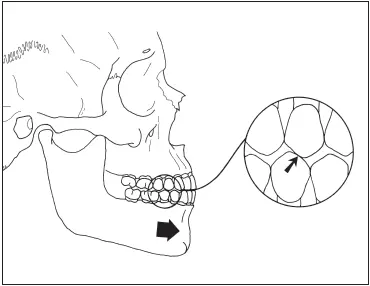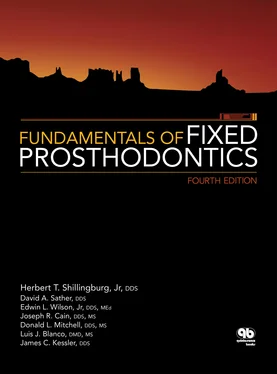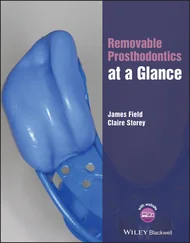1 ...8 9 10 12 13 14 ...46 
Fig 2-14A protrusive interference occurs when distal-facing inclines of maxillary posterior teeth contact mesial-facing inclines of mandibular posterior teeth during a protrusive movement.
A protrusive interference is a premature contact occurring between the mesial aspects of mandibular posterior teeth and the distal aspects of maxillary posterior teeth (Fig 2-14). Because of the proximity of the teeth to the muscles and the oblique vector of the forces, contacts between opposing posterior teeth during protrusion are potentially destructive and interfere with the patient’s ability to incise properly.

Fig 2-15(a) There may be an occlusal disharmony (shaded bar) that is not ideal but is tolerated by the patient because it is below his or her threshold of perception and discomfort. (b) If the threshold is lowered, the disharmony that had been previously tolerated may produce symptoms in the patient. (c) Treatment is then rendered by first raising the patient’s threshold and then decreasing or eliminating the disharmony. 33
Normal versus pathologic occlusion
In only slightly more than 10% of the population is there complete harmony between the teeth and the TMJs. 31This finding is based on a concept of centric relation in which the mandible is in the most retruded position. With the present concept of the condyles being in the most superoanterior position with the disc interposed, the results could be different. Nonetheless, in a majority of the population, the position of maximal intercuspation causes the mandible to be deflected away from its optimum position.
In the absence of symptoms, this can be considered physiologic, or normal. Therefore, in the normal occlusion there will be a reflex function of the neuromuscular system, producing mandibular movement that avoids premature contacts. This guides the mandible into a position of maximal intercuspation with the condyle in a less-than-optimal position. The result will be either some hypertonicity of nearby muscles or trauma to the TMJ, but it is usually well within most people’s physiologic capacity to adapt and will not cause discomfort.
However, the patient’s ability to adapt may be influenced by the effects of psychologic stress and emotional tension on the central nervous system. 32An increase in the patient’s stress level will frequently increase parafunctional jaw activity such as clenching or bruxing, and a normal occlusion can become a pathologic one 33–37( Fig 2-15). Simple muscle hypertonicity may give way to muscle fatigue and pain, with chronic headaches and localized muscle tenderness, or TMJ dysfunction may occur. Pathologic occlusion can also manifest itself in the physical signs of trauma and destruction. Heavy facets of wear on occlusal surfaces, fractured cusps, and tooth mobility often are the result of occlusal disharmony. There is no evidence that occlusal trauma will produce a primary periodontal lesion. However, when occlusal trauma is present, there will be more severe periodontal breakdown in response to local factors than there would be if only the local factors were present. 38
Habit patterns may develop in response to occlusal disharmony and emotional stress. Bruxism and clenching, the cyclic rubbing together of opposing occlusal surfaces, will produce even greater tooth destruction and muscle dysfunction.
When the acute discomfort of a patient with a pathologic occlusion has been relieved, changes that will prevent the recurrence of symptoms must be effected in the occlusal scheme. Care must also be taken when providing occlusal restorations for a patient without symptoms. The dentist must not produce an iatrogenic pathologic occlusion.
In the placement of restorations, the dentist must strive to produce an occlusion that is as nearly optimum as his or her skills and the patient’s oral condition will permit. The optimum occlusion is one that requires minimal adaptation by the patient. The criteria for such an occlusion have been described by Okeson 39:
In closure, the condyles are in the most superoanterior position against the discs on the posterior slopes of the eminences of the glenoid fossae. The posterior teeth are in solid and even contact, and the anterior teeth are in slightly lighter contact.
Occlusal forces are along the long axes of the teeth.
In lateral excursions of the mandible, working-side contacts (preferably on the canines) disocclude or separate the nonworking teeth instantly.
In protrusive excursions, anterior tooth contacts will disocclude the posterior teeth.
In an upright posture, posterior teeth contact more heavily than do anterior teeth.
Organization of the Occlusion
The collective arrangement of the teeth in function is quite important and has been subjected to a great deal of analysis and discussion over the years. There are three recognized concepts that describe the manner in which teeth should and should not contact in the various functional and excursive positions of the mandible: (1) bilateral balanced occlusion, (2) unilateral balanced occlusion, and (3) mutually protected occlusion.
Bilateral balanced occlusion
Bilateral balanced occlusion is based on the work of von Spee 40and Monson. 41It is a concept that is not used as frequently today as it has been in the past. It is largely a prosthodontics concept that dictates that a maximum number of teeth should contact in all excursive positions of the mandible. This is particularly useful in complete denture construction, in which contact on the nonworking side is important to prevent tipping of the denture. 41Subsequently, the concept was applied to natural teeth in complete occlusal rehabilitation. An attempt was made to reduce the load on individual teeth by sharing the stress among as many teeth as possible. 42It was soon discovered, however, that this was a very difficult type of arrangement to achieve. As a result of the multiple tooth contacts that occurred as the mandible moved through its various excursions, there was excessive frictional wear on the teeth. 43
Unilateral balanced occlusion
Unilateral balanced occlusion, which is also commonly known as group function , is a widely accepted and used method of tooth arrangement in restorative dental procedures today. This concept had its origin in the work of Schuyler 44and others who began to observe the destructive nature of tooth contact on the nonworking side. They concluded that inasmuch as cross-arch balance was not necessary in natural teeth, it would be best to eliminate all tooth contact on the nonworking side.
Therefore, unilateral balanced occlusion calls for all teeth on the working side to be in contact during a lateral excursion. On the other hand, teeth on the nonworking side are contoured to be free of any contact. The group function of the teeth on the working side distributes the occlusal load. The absence of contact on the nonworking side prevents those teeth from being subjected to the destructive, obliquely directed forces found in nonworking interferences. It also saves the centric holding cusps (ie, the mandibular facial cusps and the maxillary palatal cusps) from excessive wear. The obvious advantage is the maintenance of the occlusion.
The functionally generated path technique, originally described by Meyer, 45is used for producing restorations in unilateral balanced occlusion. It has been adapted by Mann and Pankey for use in complete-mouth occlusal reconstruction. 46,47
Читать дальше














